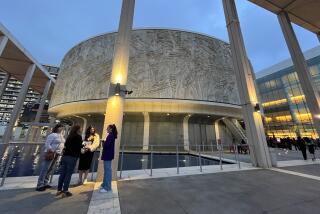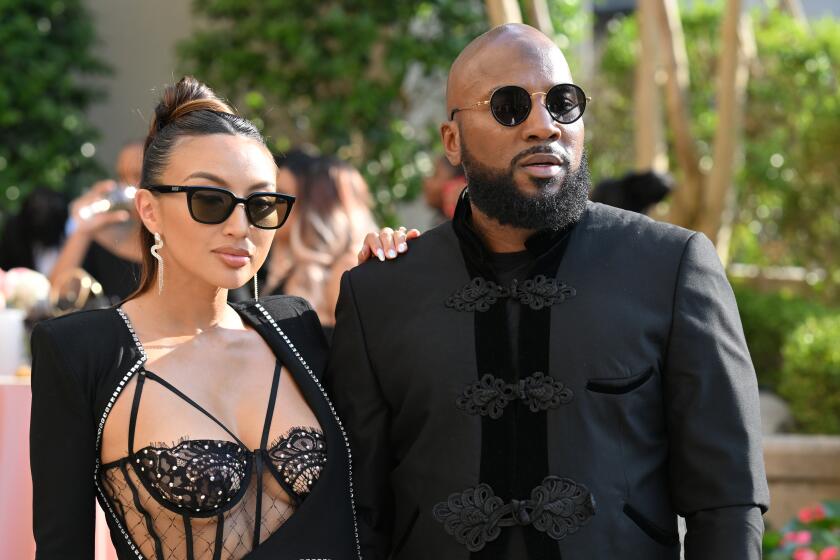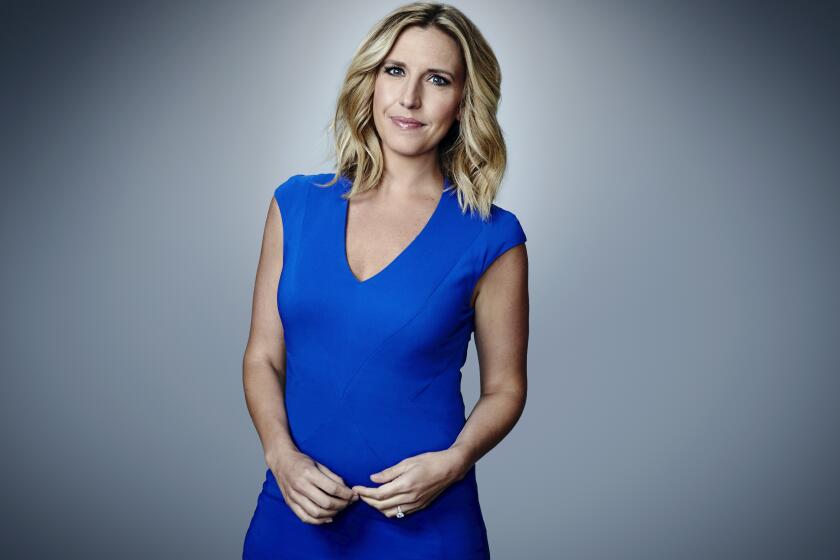Pasadena Playhouse gets direction from Sheldon Epps
Robin Givens is stirring on an antique divan, waking with a wicked hangover to several harsh realities. At least she’s not alone. Sheldon Epps, who may be one of the calmest and most self-possessed men in show business, is sitting not 12 feet away.
Epps is there to guide Givens — who became a 1980s sitcom star, then saw her marriage and divorce from boxer Mike Tyson turn into a public soap opera — and the rest of the cast of “Blues for an Alabama Sky.” Pearl Cleage’s 1995 drama, set in Harlem during the Great Depression, examines the gumption and talent it takes to hold on to one’s dreams and integrity when times are lean and how easily they can be snuffed out.
Epps is in his 15th season as artistic director of the Pasadena Playhouse. He picked this show because the aspirations and obstacles of these five fictitious black people from 80 years ago are likely to reflect the lives of a whole gamut of people right now.
As the rehearsal unfolds in a makeshift studio in a derelict furniture warehouse that itself represents one of the playhouse’s frustrated dreams, it becomes apparent that Epps, 57, sees in his mind’s eye precisely how he’d like this scene to go. It’s also apparent that the actors trust his advice whenever he rises to steer them in a soft, gentle voice.
Givens’ challenge is to master moment-by-moment emotional choreography as her character, nightclub singer Angel, begins to remember the night before, when she lost her job, her apartment and her Italian mobster sugar daddy in a single stroke. “Yep. Yep, yep, yep,” she agrees, after Epps says Angel’s first instinct is to resist rising to face what’s happened. Running the scene again, Givens adds a telling grimace of morning-after agony and dawning recognition, and the director rewards her with a chuckle. .
Few theater companies seem better qualified at this moment than the Pasadena Playhouse to dramatize disruption amid straitened circumstances and the faith and tenacity it takes to carry on. It’s the first show Epps has directed at the playhouse in more than two years. For eight months of 2010 there were no shows at all as his job shifted from staging plays to figuring out with the board and executive director Stephen Eich how to engineer the organization’s survival.
Friends Epps had made in his concurrent career directing episodes of TV series such as “Frasier” and “Girlfriends” read about his company’s plight and called him out of the blue, pledging $1 million. That hastened its emergence from Chapter 11 bankruptcy and a reopening in October 2010 on a one-show-at-a-time basis. By spring, enough stability had returned to announce the five-play 2011-12 season now underway.
“Blues for an Alabama Sky” opens Sunday; also on tap are revivals of “Art” by Yasmina Reza; “The Heiress,” Ruth and Augustus Goetz’s adaptation of Henry James’ novel “Washington Square”; and the premiere of a musical version of the film “Sleepless in Seattle.” Critics panned the September premiere of “South Street,” a musical set in a Philadelphia tavern, but playhouse board chair Michele Engemann said it was a crowd-pleaser, with sales “beyond our expectations.”
“The joy and energy he maintained in the midst of that darkness was infectious, and that’s ultimately how [the playhouse] survived,” said playwright-director Charles Randolph-Wright, Epps’ friend of more than 10 years. “I’m so proud of how he weathered that storm.”
In the months it was dark, Epps made sure to sit twice a week in the empty, 684-seat house he calls a “grand old lady.” The Spanish Colonial Revival auditorium has stood since 1925, predating all its current Los Angeles peers as a leading noncommercial stage. Here, generations of actors including Dustin Hoffman, Gene Hackman, Raymond Burr and Sally Struthers honed their art in the university-level training program it housed until 1969, when the money ran out and the theater closed for 17 years.
Sitting alone to meditate in a darkened theater was perhaps an odd thing to do, Epps says, but “for me, it was a way of keeping it alive. Somebody was in here, and if it was only me, someone was imagining the lights being on.”
Introduced at 11
The personal stakes went way back. In 1964, a busload of kids from Los Angeles had alighted at the playhouse to see Ethel Waters perform one of her signature roles, in Carson McCullers’ “The Member of the Wedding.” Little Sheldon, a preacher’s son, was 11, and it was his first play.
Soon after, Epps’ family moved to Teaneck, N.J. Having built the biggest black Presbyterian church in the west from a startup in the family’s garage, the Rev. St. Paul Epps had been tapped for a post at the national Presbyterian headquarters in Manhattan. Epps caught the acting bug in his senior year of high school and earned a theater degree from Carnegie Mellon University in Pittsburgh. A few years later, he and four of his college friends formed their own New York City troupe, the Production Company. Norman Rene, who went on to direct the films “Longtime Companion” and “Prelude to a Kiss” before his death from AIDS in 1996, led the ensemble and gave Epps his start as a director.
“He said, ‘Whenever I’m directing you and we have an argument, you’re always right. I think you ought to direct,’” Epps recalled in a smooth, precise baritone that creates an instant impression of elegance, never mind that he favors unbuttoned shirts over a dark T-shirt and jeans.
Epps started making a name for himself when he created the revue “Blues in the Night,” incorporating classic numbers from the 1920s and 1930s. It flopped on Broadway in 1982 but was a hit in London’s West End and saw frequent stagings across America. In 1996, at San Diego’s Old Globe, where he directed regularly, Epps and librettist Cheryl West launched “Play On,” transporting Shakespeare’s “Twelfth Night” to Harlem, with songs by Duke Ellington.
When Epps got the offer to run the playhouse in 1997, it was not a plum job. Since its 1986 reopening, the seasons had been less about artistic ambition than trying to give the people what it thought they wanted. By 1995 the approach had left the theater’s contracted producer bankrupt.
But Epps saw a chance to build something — and to create opportunities for black theater artists at a mainstream regional theater, not even a handful of which had been led by African Americans. “I wanted the quality of the work to be up to the beauty of this building,” he recalled.
Epps became a regular speaker at African American churches, social clubs and “pretty much anywhere people were willing to listen to me say, ‘This is a public theater. It belongs to you. I need and want you to support me, and I need and want you to feel welcome.’”
Some subscribers voted with their feet. “Part of the [concern] was whether this was going to become a black theater,” recalled Engemann. Sales declined at first, she said, but “people caught on.”
Ultimately, Epps knew, the plays would do the talking. A key selection of his first season was Tom Stoppard’s challenging British drama “The Real Thing.” He directed it himself, aiming to underscore that the playhouse was no longer serving just comfort food and that the new black artistic director was a director, period.
Plays featuring black milieus and characters have been a regular part of the recipe, and Epps in 2007 appointed Damaso Rodriguez, a Texas-raised Cuban American with a penchant for adventurous new plays, as associate artistic director. However, that position remains a casualty of the economic crisis that hit at the start of 2010, when diminished donations and earnings left the playhouse unable to cope with the debt load dating from before Epps’ arrival.
Before the downturn, the playhouse had a sold-out hit with Epps’ 2006 revival of August Wilson’s “Fences,” with Laurence Fishburne and Angela Bassett. Soon, the company was swinging for the fences as an initial staging ground for musicals with Broadway ambitions, which he sees as particularly suited to the auditorium’s opulence and scale.
In the late 2000s, with the help of outside commercial producers, the playhouse spawned “Sister Act,” an adaptation of the Whoopi Goldberg film, and “Baby, It’s You!” a jukebox musical about the Shirelles. They opened on Broadway within a week of each other last April; “Sister Act” is still running, but “Baby It’s You!” which Epps co-directed in New York, lasted only four months — a fate he seems to have handled with equanimity. There could be a small royalty if “Sister Act” does well, Engemann said — “not a huge amount, but it helps.”
The playhouse also hatched a grand scheme: In 2007 it announced that architect Frank Gehry was donating his services to renovate its campus and build a more intimate second stage on the site of the furniture store across the street. Fine as the grand old lady is for big shows, Epps says she isn’t well suited for launching the new dramas he also likes to tackle. But the company’s financial crisis killed the Gehry plan.
As the economy worsened, the playhouse turned increasingly to musicals. Since 2008, they have accounted for half the plays — double the percentage of the previous 11 years under Epps, not counting holiday shows. Musicals accounted for seven of the eight shows leading to “Blues for an Alabama Sky.”
In a 2010 commentary complaining that putting marketing ahead of creative daring had become a “widespread ill” among American theaters without substantially improving their economic lot, Times critic Charles McNulty credited Epps with presenting diverse seasons that “reflect the face of Southern California” but argued that “his taste has too often headed in an unchallenging commercial direction.”
In a poor economy, Epps said, “not only this theater but all theaters have to focus much more than perhaps we’d like to on box-office income and sales, and musicals tend to be big sellers.” As the playhouse’s finances improve, Epps hopes future seasons will offer six shows instead of five, with no more than two musicals. The Playhouse isn’t providing specific attendance, but executive director Stephen Eich said that all productions since the reopening “met or surpassed our attendance goals.”
With his contract up at the end of 2012, however, the coming year presents him with a decision beyond what plays to stage. Fifteen years is a lot for any artistic director of a major regional stage company, and no African American has served as long — among them the pioneering Lloyd Richards at Yale Repertory Theatre and George C. Wolfe at New York’s Public Theater.
Epps says the paucity of blacks leading mainstream stages factored into his past decisions to extend his artistic directorship. “I had an obligation to keep the position,” he said. Now there appear to be three blacks leading regional theaters, with Timothy Bond at Syracuse Stage in New York, and the British playwright-director Kwame Kwei-Armah recently installed at Baltimore Center Stage. But Epps says it’s “frustrating, angering and debilitating” that what he and others had hoped would become a wave of opportunities for minority theater executives remains a trickle.
Whether to re-up in Pasadena and head toward the 20-year milestone “is something I’m grappling with,” he says. His assessment of his own creative needs and what’s best for the playhouse’s future will weigh most heavily.
“I hope he stays forever. I’m thrilled with him,” says Engemann, the board chair.
Whether staying or going, Epps anticipates he’ll move ahead with a strong sense of accomplishment and pride. “The transformation and building of this theater has been the great work of my life,” he said. “It’s a great thing to have done in a theatrical lifetime.”
More to Read
The biggest entertainment stories
Get our big stories about Hollywood, film, television, music, arts, culture and more right in your inbox as soon as they publish.
You may occasionally receive promotional content from the Los Angeles Times.







